Brief description of the company
The second-largest car manufacture Ford Motor started its journey with only one car but in 2000, it manufactured more than 7.20 million vehicles worldwide with lots of successful brands especially Ford, Lincoln, Mercury, and Volvo (Ford Motor, 2000). According to the annual report, the US multinational company Ford has more than 164,000 employees and about 70 plants in the world, and in 2010, the net profit of this company was $6.6 billion, which is the maximum net profit in more than 10 years (Ford Motor, 2010, p.3-5). The entire market share of Ford Motor in the world’s automotive sector is not available in the secondary sources but the annual report provides market share for a different region.

The sustainability report of Ford is concentrated on creating a strong business by manufacturing products with outstanding features, so, it has already introduced few models like with alternative fuels and eco-friendly technologies that can run by using alternative fuels, for instance, bio-diesel and ethanol blends (Ford Motor, 2010, p.22). However, Ford Motor (2008, p.6) reported that this company will contribute to building a better world by implementing its near term, midterm, and long term project those specially designed to reduce CO2 emissions, for example, near term goal of Ford is to introduce more hybrid and diesel vehicles and to save fuel by 10% to 20%. The author Seth Leitman stated that Ford has reduced its global water consumption by 16.6% each year by implementing its projects, which also help to decrease water costs (Leitman, 2010).

Paradigm Shift and Techno Centric
Deutsche Bank (2008) reported that the consumer behavior has changed from 2005 while they purchased crossover vehicles and cars of different companies instead of traditional Trucks, and it has a great influence on the US Automobiles and Ford experienced sales reduction by $2.20 billion from Sport Utility Vehicles due to this paradigm shift.
Professor of North Carolina
State University Elizabethan O’Sullivan (1985) stated that managing information is a challenge in the present internet and technology-based world, therefore, Ford Motor has been using many information management systems and decision support systems (DSS) since 1967 to ensure the protection of information with full of confidence.
PEST analysis
Political factors
Ford Motor has to obey local rules and regulation with the recommendation of pressure groups (like Ford is an active member of the US Climate Action Partnership (USCAP) and the Environmental Protection Agency (EPA))and non-compliance with such regulation may increase the number of litigation that affects the reputation of the company (Ford Motor, 2009). However, USCAP has influenced the company to follow the US climate protection legislation to reduce CO2 production and maintain fuel economy requirements in the US and Europe zone (Ford Motor, 2009, p.5); on the other hand, the EPA forced to consider federal Corporate Average Fuel Economy law. At the same time, climate change and GHG concerns have already started to force the regulatory agenda in Europe particularly in the UK and Germany while the European Automobile Manufacturers Association (ACEA) set an objective of attaining average CO2 emission reductions of 25% compared with 1995 (Ford Motor, 2008);
Economic factors
According to the report of online journal Reuters (2011), Ford experienced lose in FY 2008 and FY 2009, but it enjoyed outstanding success in the year 2010, for example, its net income was $6.6 billion, and the share price is increasing rapidly (Reuters, 2011). However, Ford Motor (2010) reported that new model hybrid electric vehicles would play a vital role to change customer behavior and increase sales revenue from the US and European car market as MKZ Hybrid is fuel-efficient environmental friendly cars, the C-MAX Hybrid, C-MAX Energi PHEV and MKX come in the market with technologically advance eco-friendly model.
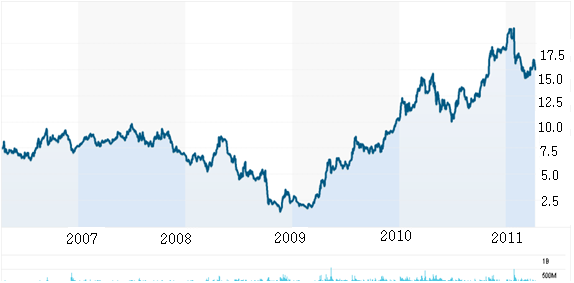
The business environment is outstanding in the US and UK for Ford, and banks of this region help the company such as it get $699 million of loans at low interest though it gets no bailout fund in recession (Ford Motor, 2010). However, the following table shows the direct comparison among major rivals of the automobile industry –
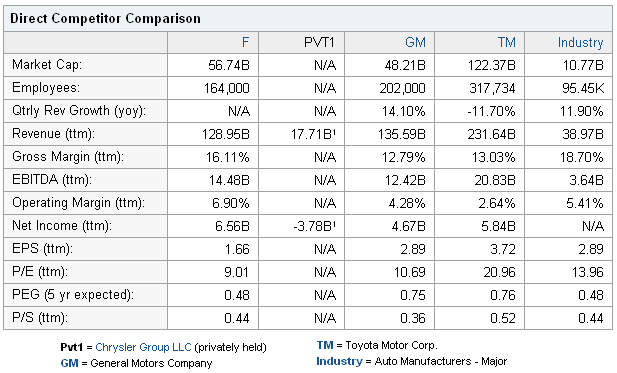
Socio-cultural factors
Climate change is related to social issues including population growth, access to mobility, and poverty improvement; therefore, in 2001, it established the Ford-Supplier Sustainability Forum to refine its social and environmental policies (Ford Motor, 2005);
Technological environment
Advance technology is an important factor to change the financial position of the company, so, Ford uses eco-friendly technologies, EcoBoost technology, driver assistance, and crash-avoidance technology, and concentrate on ECOnetic with further advanced technology to provide various vehicles that can run alternative fuels, for instance, bio-diesel and ethanol blends (Ford Motor, 2010).
Sustainable aspects of Ford Motor
Corporate Social Responsibility
Famous author John Lowry and Alan stated that large firms always have faced criticism for their contribution to social responsibility, for instance, US company Enron and Worldcom had collapsed for lack of CSR and the evidence shows that the recent global financial crisis was also the consequence of non-compliance of ethical code (Lowry & Dignam, 2007). However, in 2010, Corporate Responsibility Officer Magazine (CRSOM) has surveyed the status of human rights practice at the top hundred business entries and placed Ford Motors at the top of all others those are surveyed (Ford Motor, 2009, p.7);
Company’s ethics
Author Colin Fisher and Alan Lovell (2006) stated that the motto of ethics indicates how other people affected by the decision making of another’s morals while the rapid growth of technology and societal factors interplayed in front of business ethics; and the Ethisphere Institute deemed Ford one of the World’s Most Ethical Companies (Ford Motor, 2009, p.7).
Environmental policy
The author Perry Lawrence Johnson stated that ISO 14000 certificates involve the use of a strict environmental management system and Ford motor has achieved these certificates as this company was committed to ensuring 126 facilities by 1999 and provided a globally consistent set of environmental management performance (Johnson, 1997, p.192). Moreover, the CEO of Ford Motor intended to execute a long-term goal by launching two new hybrid electric vehicles and reducing global water consumption by 16.6% year-to-year (Ford Motor, 2009, p.2). In 2006, this company set up its next step to reduce carbon emissions and is intended to reduce CO2 emissions by 30% by 2020 and in 2009, it expanded its analysis of potential greenhouse gas emission reduction and it decreased CO2 emissions from US and European new vehicles by 12% and 6.7% (Ford Motor, 2009, p.2). According to the report of the government body US Environmental Protection Agency (1999), the key reason for Air pollution is Hydrocarbon from cars and motorcycles and this agency reported that more than 55 percent of such pollution occurs from cars. However, Ford has achieved many other awards like the Deal of the Year award, and earned its fifth consecutive Energy Star Award for Sustained Excellence from the US Environmental Protection Agency (Ford Motor, 2009, p.7);
Workplace
Ford considers workplace health and safety issues to protect the employees from any hazards, and to ensure equal opportunity; however, this company provides the opportunity to retirees and other employees to join as a volunteer (Ford Motor, 2010, p.19).
Public concern on Ford
According to the annual report 2010 of Ford, sales of Sport Utility Vehicles (SUVs) has reduced significantly in the US market due to the high price of fuel in a global financial downturn and rising public concern about the consequence of SUV emissions on global warming (Ford Motor, 2010).
On the other hand, the Auto Editors of Consumer Guide reported that the renowned brand “Ford Pinto” was started its operation in 1970, and it tried to be a market leader in North American by competing with Volkswagen, Gremlin, Vega, and Datsun (AECG, 2009). However, this brand failed to sustain itself in the market because the design of the car was too fragile, so, many accidents occurred due to wring design and the misplacement of the gasoline tank. This brand was the subject of public concerns, as it was not an environment-friendly car, it was flamed until the absolute destruction of the body of the car, and the flimsy technological design did not lessen the carbon emission (AECG, 2009).
Benchmarks and good practice of Ford
Author Curtis Darrel Anderson and Judy Anderson stated that Ford’s eco-friendly products are not popular like Toyota Prius or Honda Insight, so, Ford Motor should compare its position in terms of quality improvements, costs, working practice, better employee motivation, and focus on tasks, good practice, and development of team working (Anderson & Anderson, 2004, p.53). Author Ken Thomas (2008) stated that all the hybrid brands of Ford have to compete with other automobiles that offer similar products, for instance, Ford’s hybrid electric cars faced intense competition in the US market.
On the other hand, the existence of many substitutes creates practical difficulties while sales of Ford’s hybrid-cars like Ford Escape or Mercury-mariner is lower than the hybrid-cars of other companies like Toyota-Prius, Toyota-Camry, Lexus RX-400h, Honda-Civic, Honda Insight, and Honda-Accord, and other environmentally friendly cars of different companies (Anderson & Anderson, 2004, p.53,) and (Thomas, 2008). However, In October 2006, in the US, Toyota’s hybrid sales were 77%, Honda’s were 14%, and Ford’s were merely 9% (hybridCARS, 2010); however, the following figure demonstrates the yearly sales statistics of hybrid cars in the US market from 1999 to 2006 period; it is noticeable that the sale of Ford Escape is far below its competitors (hybridCARS, 2010). However, the following figure shows the Yearly Hybrid Sales of Ford by comparing with other products –
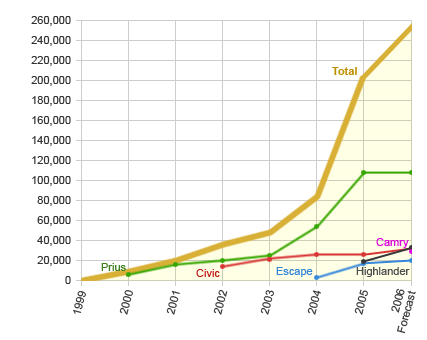
According to the annual report 2010 of Ford, it has taken few initiatives to upgrade its position in this segment, such as, in 2009, it started to use lithium-ion batteries in commercial vans power connection, and it is going to introduce the 2011 Lincoln MKZ Hybrid, plug-in hybrid electric vehicle and hybrid electric vehicles (Ford Motor, 2010).
Functional strategies of Ford
According to the annual report 2010 of Ford, it continued to concentrate on executing the four major concerns of its One Ford plan is the right strategy to accomplish its goals, such as –
- It would reshape to operate gainfully at the present demand and shifting model mix;
- Advance and introduction of new products considering customers choice;
- More investment on the prospective segments;
- Controlling the employees to work as a team (Ford Motor, 2010, p.26);
- On the other hand, it has maintained other functional strategies like closing 3 Ford-plants and 1 ACH-plant from FY2010 to FY2011, decreasing automobile debt by $10.1bn, and utilizing $2.6bn in automobile (Ford Motor, 2010).
Analysis: Effects of sustainable investment by Ford
Innovation
Ford Motor (2010) reported that it continues to establish the next border of safety with innovations for instance inflatable seat belts and curve control, liquid-injection petroleum gas (LPG) system along with other innovative global technologies like PowerShift transmissions, which will help to reduce environmental pollution, increase safety measure and reduce fuel consumption by 20%.
Brand Reputation
Author Rajendra Srivastava and Gregory Thomasa stated that a strong brand provides a consistent way to polarize multiple micro-decisions, and Ford failed to spot the bottom of the market especially it is out of touch with its heritage; however, it has a global market presence, with universal brand recognition and a particularly strong presence in European and US market.
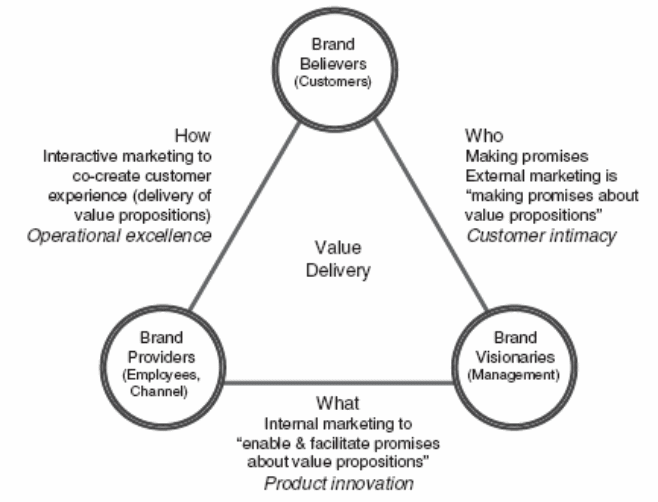
New markets
Ford Motor (2010) mentioned that Ford is going to launch several new products by 2012, such as Fusion hybrid, MAX Hybrid, C-MAX Energi PHEV, and MKX, which would mainly be designed for the US and European customers as they are driving for eco-friendly cars.
Strategic ignorance of sustainable issues of Ford
Non-attendance of Ford motors to implementing sustainable strategic practices like the introduction of hybrid car or biofuel technology does not necessarily mean cost-effectiveness; in addition, the company has to invest huge fund to R&D to develop these new models though the failure of designation may increase legal cost and destroy reputation (Ford Motor, 2010).
Stakeholder Analysis
Johnson, Scholes & Whittington (2008) stated that Ford Motor persistently supervise and ensure whether the stakeholders of the company are satisfied with the business performance in terms of services for customers, revenue generation for the shareholders, managers, creditors, and owners, and market-leading position, remuneration of the employees. However, Professor of Marketing Michele D. Bunn, Professor of Management Grant T. Savage, and Ph.D. Candidate Betsy B. Holloway (2002) stated the five-step stakeholder analysis process and step four of this research discussed Telematics and dominant stakeholder process by providing example Ford’s joint venture with Qualcomm. However, Ford Motor has both internal and external Stakeholders those have different concerns on Ford motors like unions concentrate on workplace safety issues, employees consider environmental issues, employees, 1,600 production suppliers provide quality parts, 165,000 investors concern about returning the company to profitability, and so on (Ford Motor, 2011). However, the figure below analyses the main internal and external stakeholders of Ford –
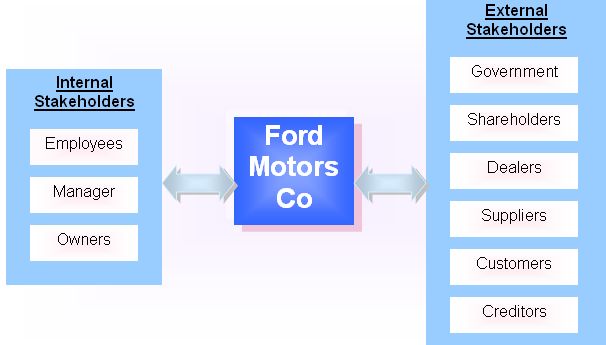
Key Recommendations
This report demonstrates the effort of Ford Motor to reduce carbon emissions, the eagerness of the company to maintain corporate social responsibility, and other initiatives. However, this company has to face many unusual situations to operate in the global market; so the following suggestion would be helpful for the company to overcome such challenges or risks.
- The present market position of competitors like General Motors and Chrysler is not stable enough and these companies experienced huge losses due to global financial downturn; so, Ford should be more cautious regarding bankruptcy or liquidation as it could gravely disturb its supply chain management system;
- Ford should try to imply the ‘One Ford’ vision and carry out its sustainability goals to differentiate itself from major competitors but it should not lose sight of the bigger picture while endeavoring to take advantage of the current weakness of these companies;
- However, Ford should reduce the truck or SUV production as the sales revenue form these products have dropped dramatically due to the high price of fuel and it would be difficult to shift the production speedily to meet changing demand;
- The marketers should change their moral view to customers and the engineers of this company should design the products considering environmental factors and customers safety issues because the brand “Ford Pinto” had destroyed its reputation to the automobile users though the marketers spent huge fund to improve its design;
- In addition, Ford should not design the products such a way, which could increase the number of accidents;
- It should continue its initiatives to reduce water consumption, and carbon emissions by introducing hybrid electric vehicles and pure battery-electric;
- Finally, it should follow the divestiture strategy to concentrate on its single vision and it can reduce its number of suppliers to stable its supply chain.
Conclusion
The changing pace of the automotive industry in terms of rivalry and rising concentration on eco-friendly approaches through the development of brand new cars has made Ford Motor Company come up with several models with substitute energy sources and green technologies, which uses unconventional fuels like bio-diesel and ethanol. The introduction of new technologies by other industry giants like General Motors Company, Chrysler Group LLC, Toyota Motor Corporation, Honda Motor Company, Nissan Motor Company, etc to reduce environmental pollutions meant that it was essential for Ford Motor to launch highly fuel-efficient Hybrid models to boost sales in highly competitive situations. In doing so, the company had to undertake several strategic approaches, which included tactics such as an increase in expenditure on research and development to inaugurate fast intensification of technology and the utilization of an authoritarian ecological management scheme to ascertain an internationally reliable set of environmental management performance.
Moreover, the assurance of a globally sustainable operational practice required the company to propose to diminish Carbon Dioxide emissions thirty percent by 2020, implement enduring objectives by initiating two new hybrid-electric models, lower its international water consumption by 16.6 percent, and taking into account workplace security concerns to safeguard the workers from any exposure to toxic pollutions. In addition, the company focused on carrying out its plans to achieve its operational targets, for example, reforming management profitably and shifting product line, progressing and pioneering new vehicles, spending more on the potential areas, scheming the workforce to enhance teamwork, and so on. It is important to argue that if Ford was not able to come up with these strategic approaches and implementations towards sustainable management, it was likely that the company would have been facing many legal barriers relating to environmental and labor legislation, and confront numerous grievances for rising pollution levels by the company’s vehicles followed by damage to its reputation. Nevertheless, because the company now possesses a series of different approaches to sustainable management, several of which have already been implemented, and the rest are being closely observed to be executed very shortly, Ford has the potential for more well-managed organizational practices for the future.
Reference List
AECG (2009). 1971-1980 Ford Pinto. Web.
Anderson, C.D. & Anderson, J. (2004) Electric and hybrid cars: a history. NY: McFarland & Company.
Bunn, M.D., Savage, G. & Holloway, B. (2002) Stakeholder analysis for multi-sector innovations. Journal of Business & Industrial Marketing 17(2/3) pp. 181-203.
Deutsche Bank (2008) US Autos and Auto Parts: Paradigm Shift for the GlobalAuto Industry. Web.
Fisher, C. and Lovell, A. (2006) Business Ethics and Values. 2nd ed. London: Prentice Hall.
Ford Motor (2000) Customer Profile: Ford Motor Company. Web.
Ford Motor (2005) Ford Report on the Business Impact of Climate Change. Web.
Ford Motor (2008) Blueprint for Sustainability. Web.
Ford Motor (2009) Blueprint for Sustainability.Web.
Ford Motor (2010) One Ford Annual Report 2010: Ford Motor Company. Web.
Ford Motor (2011) Who Are Our Stakeholders? Web.
HybridCARS (2010) October 2006 US Sales. Web.
Johnson, P. L. (1997) ISO 14000: the business manager’s complete guide to environmental management. 1st ed. London: John Wiley and Sons.
Johnson, G., Scholes, K. & Whittington, R. (2008) Exploring Corporate Strategy: Text & Cases. 5th ed. London: Prentice Hall
Leitman, M. (2010) Ford Motor Company Actually Cut Water Consumption..Really?. Web.
Lowry, J. & Dignam, A. (2007) Company Law. 4th ed. London: Oxford University Press.
O’Sullivan, E. (1985) Decision Support Systems: An Introduction for Program Evaluators. Evaluation Review, 9(1), 84-92.
Reuters (2011) Chart: Ford Motor Co (F). Web.
Srivastavaa, R. K. & Thomasa, G. (2010) Managing brand performance: Aligning positioning, execution and experience. Journal of Brand Management 17, 465 – 471.
Thomas, K. (2008) Ford products lead list of safest cars. Web.
US Environmental Protection Agency (1999) Mobile Source Emissions – Past, Present, and Future. Web.
Yahoo Finance. (2011) Direct Competitor Comparison Ford Motors. Web.